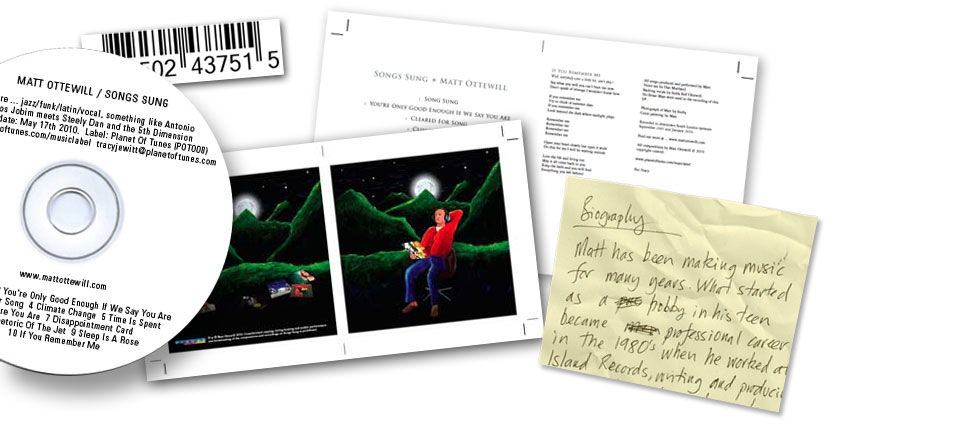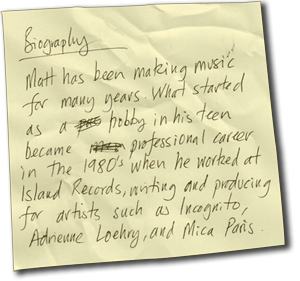- It's hardly surprising that so few artists manage to effectively release a CD themselves, there are so many tasks and skills required.
- Although the timeline of tasks set out below may seem obvious and essential, they constitute only one of many possible approaches. These are tried and tested methods of marketing and promotion, but you may have an entirely new and innovative alternative approach.
- Carrying out the tasks below is not enough to ensure success, this is just the nuts and bolts stuff. What every artist needs is something brilliant. This may be a video, a method of performing, innovative music or a unique strategy. There is no single brilliant idea that will work for everyone, it needs to be an extension of what you are and do.
NOTE: You may also wish to read our comprehensive article on Selling Music Online which is referred to in this article.
You may also want to consider carefully whether or not you want to sell physical CDs. Doing so adds a huge layer of expense and tasks to the process of self releasing. You may decide to opt for a digital distrubution release only, in which case you can spend you time and budget on digital marketing. Our guide on "Digital Marketing Essentials for Recording Musicians" from our sister site, Project Studio Handbook, is an essential read.
Tasks
The following is a chronological list of the tasks I undertook, once I had finished mixing and mastering my album. I decided that I wanted to sell physical CDs and MP3 downloads from the web and ignore traditional distribution to shops for the time being. However, because I would have physical CDs duplicated for sale online, I could sell through bricks and mortar retail at a later time if I wanted to. Also, I could sell CDs at gigs.
01 Choose a digital/physical product distributor
The best option for getting your music to as many retail outlets as possible is to find a single distributor (aggregator) who can do it for you. You can make multiple arrangements with individual specialists (bricks and mortar retail, iTunes, Amazon etc) but this will be time consuming and many retailers won't deal with individual artists.
I used CDBaby. They are an excellent online retailer and distributor with many innovative ideas and great support. They allow you to decide on pricing and how and where you want to sell. The agreement you make with them is non-exclusive and on an album by album basis, so you can make additional individual deals with other retailers if you wish, and sell from your own web site.
Read more about organisations like CD Baby here
02 Acquire a UPC barcode
If you are going to sell physical CDs it makes sense to get a barcode before you create your CD artworks. It's not expensive and it gives you the option to sell through Amazon and bricks and mortar shops. These types of retailers require a barcode to be displayed on product packaging so they can track stock.

If you are having your CDs professionally reproduced (pressed) you can usually get a barcode from the manufacturer. Do this early on in the process so you can add it to your artworks. I got my barcode from CDBaby.
A full explanation of barcodes is here
03 Create a record label
If you don't already have a record label, it makes sense to dream one up now. You can then register your label for ISRC codes, release your own work under different names, and by other artists, and allow people to search for releases by you label name. It's altogether a more elegant approach than using a single artist name. Check thoroughly to ensure there are no other labels with the same name.

You don't have to register your label name in any way if you don't want to. Owning the .com domain and having it registered for IRSC codes (see below) should secure it.
You will need a logo. Once you have created artwork for it, backup your files to several CD-Rs in hi-res (300dpi) RGB Photoshop format, and if applicable EPS too. Don't forget to convert any fonts you use into outlines. You may find it a good idea to create master print and web ready versions for future use.
More on creating images and artwork is here
CD text and ISRC code entry in Apple Waveburner
CD mastering software
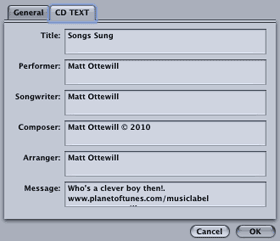
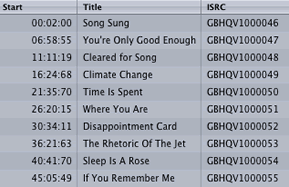
04 Assign ISRC codes to each album track
Once you have generated your codes, you will be able to assign each track of your CD with a unique number. Keep a record of these.
A full explanation of ISRC codes and how to register for them is here.
05 Create a CD production master, complete with UPC, ISRC, and CD Text info
Enter the ISRC codes of each track into your CD red book production master software. You can add your barcode too if you wish, though this is less important. It makes sense to add CD Text including each track name and copyright information too.
Once your CD master is complete, burn and test it first on as many players as possible, then create 4 or 5 DVD-R data backups complete with your multitrack session files. You may wish to do this once you have your CD artwork complete so you have a complete and definitive backup of the finished product.
06 Register compositions/recordings with performance royalty collection agency (PRS in the UK)
In order to receive royalties from radio plays and live performance of your songs you need to register with the appropriate agency in your territory.
07 Create MP3 versions
You will need short MP3 preview edits for the retail page of your website. I use high quality (224Kbps, 44.1KHz, stereo) encoding so buyers can hear the tracks clearly. I usually choose a verse and chorus so the files are generally 80-100 seconds long.
Your digital distributor may give you the option of submitting the previews you have prepared for them to use. This is a good idea because it gives you control over the quality and edits.
Additionally I choose to give away 2 tracks as free downloads. I use the same encoding settings for these.
08 Take photographs for CD artwork and website/marketing use
It is likely that you will need some photography for your press release, CD artwork and web site. Customers/fans like portraits and additional photos of you recording, performing etc and it can help retail if you have images to help promote your product. You will almost certainly need some portraits of the performer (you?). I think these used to be called "promo shots". Whatever you do, think carefully about how you want to represent yourself and how the images will enhance the message of your product. If you can't be beautiful, be original.
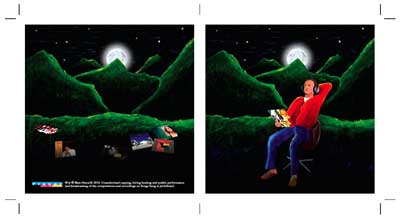
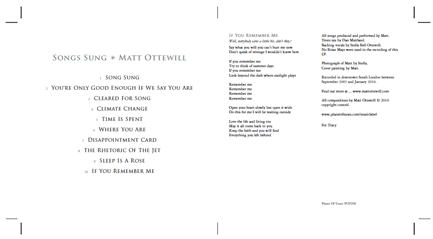
09 Create print ready CD artwork and label artwork
If you are using a manufacture to press your CDs, they will almost certainly offer an artwork service for the inlay/wallet/booklet etc and label. You will need to supply them with images, text and an idea of the design.
If you want to do it yourself, there's plenty of help here. Your artwork must be 300dpi, CMYK in press ready PDF format.
10 Create print and web ready marketing images
You will need to have hi-quality flattened image versions of at least the front cover of your CD, and perhaps portraits and other images to use on printed press releases, retail web sites, your web site, and perhaps for T-shirts and posters etc. Again 150-300dpi is best for print, you can down sample images to 72dpi for web use.
11 Arrange CD duplication
Send off your CD master and artwork, get a proof / test copy to check before mass duplication starts, and then ask when they will be delivered.
12 Set a release date
When you know when your CDs will be delivered, you can set a release date of 6-8 weeks later. You will need this lead-up time to ensure press and broadcast media get your press release and white label CDs well before the release date.
13 Organise and book a launch event/gig and as many following promotional gigs and appearances as possible
You will want to synchronise this with the release date. At the very least you enjoy yourself by playing your music to family and friends. This can be a good fun thing to do and imparts even the most modest projects with a sense of occasion.
14 Submitted album track and artist info to the Gracenote database
Whenever someone puts your CD into their computer it is likely that the computer will try to retrieve and track and artist details. iTunes uses Gracenote. Launch iTunes, insert a copy of your finished production master, iTunes will ask you if you want to submit the details and follow the prompts.

Read more about Gracenote here
15 Write short and long descriptions of the album
You will need a short snappy sentence that describes your album. I found this very difficult! I finally settled on ... "Ten latin-funk-jazz songs for lovers of the music of Antonio Carlos Jobim, Prefab Sprout, Steely Dan and Burt Bacharach". No doubt you can do better, but try to avoid cliched lines like "... the eagerly anticipated new album ..." or "... the new Bob Dylan ..." or "... sublime and though provoking intimate songs to make you believe in music again...". Don't big up your own music but don't sound apologetic or modest either. Write something descriptive that doesn't attempt to elevate the music's worth. That's for others to do.
You may also have the opportunity to submit extra information about the artist (you?) and the project to online retailers. Try to find something interesting that enhances and complements the albums "message".
16 Write an artist biography
You may need 2 versions of this. One longer version for your own web site and online retailers, and one for press releases.
The press release version should be short and contain only interesting facts that a reviewer or broadcaster could use. See 25 below for mine.
17 Decide how much you are going to charge
Check that your distributor allows flexible pricing and then make some pricing decisions for physical CDs, album downloads, individual track downloads, and bulk buyer discounts. You may want to undercut your distributor with a lower price for customers who buy direct from your website.
Don't charge too little or customers may think your music has no value. Don't charge too much, you don't want to put them off.
18 Upload to your distributor
Upload album description, information, artist portraits, CD cover artwork, MP3s etc to your digital/physical distributor. Determined your retail preferences (price etc) and complete the agreement. Set the release date. A good system (such as CD baby's) will walk you through all the processes in a clear and flexible way.
19 Send physical CDs to your distributor
If your distributor is going to sell CDs from their site, or distribute them to other online retailers, you will need to send them some initial stock.
20 Created a promo music video
The best way to create interest in your music is with video. You already know this because you watch music videos on YouTube, right? Customers love to watch and listen. With high quality inexpensive camcorders and editing software you have no excuse not to. You just need a great idea. If you're not up to it, try to find a film student who will make one for you.
Remember to add your site URL to captions during the edit.
You will find advice on producing video here
21 Upload your music video
Upload to everywhere you can including your site, your MySpace site, YouTube, digital retail sites (eg Amazon).
You will find advice on optimising and adding video to web sites here
22 Add your album to your site
This may be a label site or an artist site or both. Don't rely on social network and template based sites like MySpace, they look amateur. You need a professional, well designed and thought out site. It is the single most important marketing tool you have and its design and content must convey your music and message.
You will need ...
- Album description
- Album artwork
- MP3 previews
- Retail links
- Extras such as video, free tracks etc
Check out my site for ideas ...
23 Link social media profiles to the album page on your site
Provide links to your site to ensure that customers and fans can hear and buy your CD. On your site, provide Share, Follow and Subscribe buttons. This guide on "Digital Marketing Essentials for Recording Musicians" from our sister site, Project Studio Handbook, is an essential read.
24 Research media contacts relevant for the type of music, to solicit airplay and reviews
You will need the names, job titles and addresses of music journalists/reviewers, TV programme producers and radio programme producers. Target your music, there is no point in sending a heavy metal project to a country and western station or programme.
Enter all your contacts into a database from which you can email, and print address labels and mail-merge letters/press releases. This could be the same database you use for your mailing list.
25 Write a concise bio/press release
You will need this to send to your media contacts. Utilise the short album description and biography you have already created.
26 Create and duplicate white label CDs and a basic plastic wallet insert/inlay
Note: You may decide to forego this step and just use email and MP3s to get your message to potential media and reviewers.
You will not be sending complete manufactured CDs to your media contacts. They will expect pre-release white label CDs in a simple plastic wallet (not a jewel case) together with your press release. Fancy packaging is a waste of time.
You will need to duplicate audio CDs and have basic artist, track and contact information printed on the CD itself and a simple accompanying insert. Both should use a simple readable font (eg Arial), black and white print. Do not write information onto the CDs with a pen, print it. There are plenty of cheap inkjet's that can handle this.
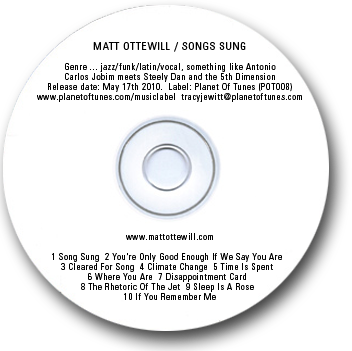
27 Send your press releases to your media contacts
Note: You may decide to forego this step and just use email and MP3s to get your message to potential media and reviewers.
You need to do this 8-6 weeks before release date. Print address labels from your database and duplicate your press release. Use simple jiffy bags or cartons made for posting CDs.
28 Check online retail outlets
As you approach the release date you will need to check that retailers have "published" your album page, there are no typos/errors, and the retail system works. Once you are satisfied, link your site to them.
If you are selling direct from you site (PayPal?), go through any necessary setup procedures and add the relevant links and code. Test it. You may wish to offer customers a money back guarantee or use other methods to reassure them.
29 Submit a site map to Google
Ensure Google can find your album page. Advice is here
30 Ask friends to write reviews
If you can, solicit favourable reviews to add to retail sites and your social media profiles (eg Google+). They are important. At the very least find a way to encourage customers to add reviews once they've bought it. Or else manufacture some.
31 Chase up your media mail out
Encourage them to find your email or press release and CD amongst the 1000's of others by sending an email reminder.
32 Create a marketing HTML email
If you can, create a simple but effective html email which provides a link to the album page on your site and offers something extra like free downloads or a video. Here's mine.
If this is too technical for you, either use a professional web based service (Mailchimphas features for musicians) or at the very least attach some simple images to a conventional email. This guide on "Digital Marketing Essentials for Recording Musicians" from our sister site, Project Studio Handbook, is an essential read.
33 Send your marketing email to your mailing list
Do this on the day of release.
34 Promote your album on social networking sites
Use YouTube, Google+, Twitter and Facebook as a minimum. Encourage as many shares as you can. Get your friends and fans to spread the word.
35 Launch event and gigs
Time to relax. Oh no it isn't! Get out there and take your music to the people!
Final thoughts
Are you beginning to understand exactly what record companies, managers, record pluggers etc do for their money? It took me a whole day just to duplicate and post 20 press releases!
I sincerely hope that this brief overview will be of use to you. Good luck.
